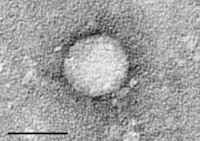
Photo from wikipedia
Rotaviruses have a genome composed of 11 segments of double-stranded RNA. Whether all 5′ ends of the positive-sense genomic RNAs contained in the mature viral particles are modified by a… Click to show full abstract
Rotaviruses have a genome composed of 11 segments of double-stranded RNA. Whether all 5′ ends of the positive-sense genomic RNAs contained in the mature viral particles are modified by a cap structure is unknown. ABSTRACT Viruses have evolved different strategies to overcome their recognition by the host innate immune system. The addition of caps at their 5′ RNA ends is an efficient mechanism not only to ensure escape from detection by the innate immune system but also to ensure the efficient synthesis of viral proteins. Rotavirus mRNAs contain a type 1 cap structure at their 5′ end that is added by the viral capping enzyme VP3, which is a multifunctional protein with all the enzymatic activities necessary to add the cap and also functions as an antagonist of the 2′-5′-oligoadenylate synthetase (OAS)/RNase L pathway. Here, the relative abundances of capped and noncapped viral RNAs during the replication cycle of rotavirus were determined. We found that both classes of rotaviral plus-sense RNAs (+RNAs) were encapsidated and that they were present in a 1:1 ratio in the mature infectious particles. The capping of viral +RNAs was dynamic, since different ratios of capped and noncapped RNAs were detected at different times postinfection. Similarly, when the relative amounts of capped and uncapped viral +RNAs produced in an in vitro transcription system were determined, we found that the proportions were very similar to those in the mature viral particles and in infected cells, suggesting that the capping efficiency of VP3, both in vivo and in vitro, might be close to 50%. Unexpectedly, when the effect of simultaneously knocking down the expression of VP3 and RNase L on the cap status of viral +RNAs was evaluated, we found that, even though at late times postinfection there was an increased proportion of capped viral RNAs in infected cells, the viral particles isolated from this condition contained equal ratios of capped and noncapped viral RNA, suggesting that there might be selective packaging of capped and noncapped RNAs. IMPORTANCE Rotaviruses have a genome composed of 11 segments of double-stranded RNA. Whether all 5′ ends of the positive-sense genomic RNAs contained in the mature viral particles are modified by a cap structure is unknown. In this work, we characterized the relative proportions of capped and noncapped viral RNAs in rotavirus-infected cells and in viral particles by using a direct quantitative assay. We found that, independent of the relative proportions of capped/noncapped RNAs present in rotavirus-infected cells, there were similar proportions of these two kinds of 5′-modified positive-sense RNAs in the viral particles.
Journal Title: Journal of Virology
Year Published: 2022
Link to full text (if available)
Share on Social Media: Sign Up to like & get
recommendations!